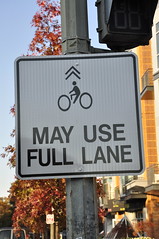Cycling 101: Lane position
Recent discussion about Robert Johnson's article in the Columbia Tribune about lane positioning for bicyclists made me think of this classic article by Mighk Wilson, Freedom from Fear.
The entire article is long but well worth reading.
When it comes to the practice of "taking the lane"--bicycling near the right tire track or center of narrow lanes, rather than hugging the right-hand curb--here is what Wilson has to say:

Now we come to cycling-specific practices. Taking the lane is the most important cycling-specific practice because the ones mentioned above won’t discourage motorists from passing you in an unsafe manner. If the lane you’re in is too narrow for a motorist to pass you safely and you keep all the way to the right, some motorists will try to pass you within the same lane. This is both dangerous and unpleasant. Dangerous because you will have no room to maneuver around a road hazard and the motorist may even sideswipe you. I guess I don’t have to explain "unpleasant."
Another very important practice is keeping at least three feet from the driver-side doors of cars parked on the roadway. This very similar to taking the lane. In big cities like New York and San Francisco "dooring" is a very common and serious crash.
Taking the lane is something I’ve only been doing since I read Effective Cycling about six years ago. I’ve noticed a few important things since then. First is that I have far fewer close calls with passing cars. My roadway position forces motorists to give me a wider gap. I’ve found it to be less stressful cycling this way. No, I do not experience more annoyed or aggressive motorist behavior. But when a motorist does get annoyed and passes aggressively I have much more room to maneuver. As for the threat of the inattentive overtaking motorist, all I can say is I’ve yet to hear the sound of squealing brakes coming from right behind me. Horns? Yes, but no more than before.
FYI, bicyclists are allowed to use the full lane in pretty much every state, including Missouri, if the lane is too narrow to share with another vehicle (see 307.190 RSMo). "Too narrow to share" is normally defined as a lane narrower than 14 feet in width--which describes most travel lanes in the state of Missouri.
The "too narrow to share" provision is a principle of traffic law in every state and is the basis of the "Bicycles May Use Full Lane" sign which has now been officially adopted by the Manual on Uniform Traffic Control Devices--the manual created by and for state traffic engineers.
Take a look at Chapter 2 of Street Smarts by John Allen for more information on lane positioning. Allen summarizes:
Many cyclists believe they are safer and more comfortable riding further to the right than this booklet recommends. They fear being passed uncomfortably close by a motorist, or feel intimidated by impatient drivers. Riding too far to the right is very dangerous for several reasons. It puts the cyclist in the danger zone of poor sightlines and opening car doors; it invites motorists to attempt topass to closely; and it takes away the cyclist's escape route to the right in the event of the unexpected. The correct lane positions described in this booklet are the safest and most efficient. Do not be intimidated. Take responsibility for your own safety, even if other traffic must occasionally slow and follow you.
- Cycling Tips and Stories
- 2012
- about
- bicycle
- bicycles
- bicycling
- bicyclists
- blog
- cars
- columbia
- crash
- cycling
- cycling 101
- cyclist
- drivers
- escape
- first
- form
- missouri
- missouri bicycle federation
- mobikefed
- motorist
- riding
- rules
- safety
- story
- traffic
- unsafe
- Bicycle law in California
- Columbia Tribune
- Cycling
- Effective Cycling
- John Allen
- Lane
- Lane splitting
- Missouri
- New York
- Road transport
- Robert Johnson
- San Francisco
- Traffic
- Vehicular cycling
- Wide outside lane
- WILSON
Join MoBikeFed's Advocacy Network
Working together we make a real difference! Join our advocacy network:
Related pages
Current topics...
Archives...
Want better bicycling and walking in Missouri?
We rely on the support of members like you. Please join, renew, or donate today.
- Home
- JOIN/DONATE
- News/Info
- Missouri Bicycling, Running, Trails
- Bicycle Skills and Safety
- Missouri Bike/Ped Law
- Clubs and Organizations
- Bike Shops
- Running Shops
- Bicycling, Running, Trails-related Businesses
- Ride, Run, Walk, Hike, Triathlon, and Events Calendars
- Bicycles on Amtrak
- Maps and Routes
- Trails and Trail Maps
- IBikeMO.org
- Planning a Missouri bicycle trip
- Gravel and Bikepacking Maps & Routes
- Bicycle & Touring Routes
- Advocacy
- Campaigns
- Our Legislative Platform
- Complete Streets
- Statewide Rock Island Trail
- Statewide Trail Vision - Quad State Trail
- Bicycle Friendly Missouri
- Walk Friendly Missouri
- Safe Routes to School
- MoDOT funding crisis
- High Priority Bike/Ped Project List
- Anti-harassment laws in cities & statewide
- Updating the basic bicycle law
- Our Vision for MoDOT
- Our Vision for MPOs/RPCs
- Our Vision for Cities & Counties
- Bicycle, pedestrian, trails plans across MO
- Protecting Vulnerable Road Users
- Vision Zero
- Missouri Trail Towns
- Store
- About

